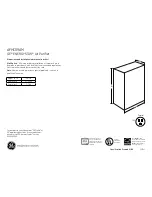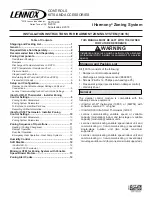
SS-SVX11K-EN
101
N
No
otte
e:: Before condemning the sensor, verify that
the connecting cable resistance is not
excessive. Refer to the “Field Installed
Control Wiring” section.
5. Make all necessary repairs and reconnect the duct
sensor lead to terminal T1 on the controller.
6. Turn all control switches to the “ON” position and
restore power to the system.
Master Energy Control Checkout
A
Av
va
aiilla
ab
blle
e O
On
nlly
y F
Fo
orr 2
20
0 -- 6
60
0 T
To
on
n U
Un
niittss
W
WA
AR
RN
NIIN
NG
G
H
Ha
azza
arrd
do
ou
uss V
Vo
olltta
ag
ge
e!!
F
Fa
aiillu
urre
e tto
o d
diisscco
on
nn
ne
ecctt p
po
ow
we
err b
be
effo
orre
e sse
errv
viicciin
ng
g cco
ou
ulld
d
rre
essu
ulltt iin
n d
de
ea
atth
h o
orr sse
erriio
ou
uss iin
njju
urry
y..
D
Diisscco
on
nn
ne
ecctt a
allll e
elle
eccttrriicc p
po
ow
we
err,, iin
nccllu
ud
diin
ng
g rre
em
mo
otte
e
d
diisscco
on
nn
ne
eccttss b
be
effo
orre
e sse
errv
viicciin
ng
g.. F
Fo
ollllo
ow
w p
prro
op
pe
err
llo
occkko
ou
utt//tta
ag
go
ou
utt p
prro
occe
ed
du
urre
ess tto
o e
en
nssu
urre
e tth
he
e p
po
ow
we
err
cca
an
n n
no
ott b
be
e iin
na
ad
dv
ve
errtte
en
nttlly
y e
en
ne
errg
giizze
ed
d.. V
Ve
erriiffy
y tth
ha
att n
no
o
p
po
ow
we
err iiss p
prre
esse
en
ntt w
wiitth
h a
a v
vo
ollttm
me
ette
err..
1. Open the system control switches 5S1 and 5S2 to
disable the Evaporator Fan and Heating system.
2. Verify that the main power disconnect switch and
the control circuit switch 1S2, in the unit control
panel, is “OFF”.
3. At the Master Energy Controller (7U11), in the unit
control panel, remove at least one wire from each
of the “Heat Relay” normally open contacts and
one from each of the “Cool Relay” normally open
contacts. Insulate the wires with tape to prevent
shorting or grounding during control checkout.
4. Close the main power disconnect switch and turn
the control circuit switch 1S2, in the unit control
panel, “ON”.
W
WA
AR
RN
NIIN
NG
G
L
Liiv
ve
e E
Elle
eccttrriicca
all C
Co
om
mp
po
on
ne
en
nttss!!
F
Fa
aiillu
urre
e tto
o ffo
ollllo
ow
w a
allll e
elle
eccttrriicca
all ssa
affe
etty
y p
prre
ecca
au
uttiio
on
nss
w
wh
he
en
n e
ex
xp
po
osse
ed
d tto
o lliiv
ve
e e
elle
eccttrriicca
all cco
om
mp
po
on
ne
en
nttss cco
ou
ulld
d
rre
essu
ulltt iin
n d
de
ea
atth
h o
orr sse
erriio
ou
uss iin
njju
urry
y..
W
Wh
he
en
n iitt iiss n
ne
ecce
essssa
arry
y tto
o w
wo
orrkk w
wiitth
h lliiv
ve
e e
elle
eccttrriicca
all
cco
om
mp
po
on
ne
en
nttss,, h
ha
av
ve
e a
a q
qu
ua
alliiffiie
ed
d lliicce
en
nsse
ed
d e
elle
eccttrriicciia
an
n
o
orr o
otth
he
err iin
nd
diiv
viid
du
ua
all w
wh
ho
o h
ha
ass b
be
ee
en
n p
prro
op
pe
errlly
y ttrra
aiin
ne
ed
d
iin
n h
ha
an
nd
dlliin
ng
g lliiv
ve
e e
elle
eccttrriicca
all cco
om
mp
po
on
ne
en
nttss p
pe
errffo
orrm
m
tth
he
esse
e tta
asskkss..
5. At the Master Energy Controller, use a digital
voltmeter to verify that there is 20 volts DC power
between terminals 1 (N) & 2 (+20). Refer to the
illustration in Discharge Air Controller Checkout
(Honeywell W7100A) section for terminal
identification.
N
No
otte
e:: The wires that are still connected to one side
of the “Cool Relay” contacts, are active with
115 volts applied. Measuring the contacts
when only one wire is connected will not
cause any damage to the ohmmeter.
However, do not try to ohm any set of
contacts with wires connected to both
terminals of that contact.
6. To verify the “Heating” output relays are operating;
a. place a jumper between Terminals 2 (+20) & 5
(H).
b. place the ohmmeter leads across each set of
normally open “Heat Relay” contacts. The
ohmmeter should read “Resistance” which
indicates that the heating output relays have
“pulled in”.
7. To verify the “Cooling” output relays are operating;
a. Remove the jumper from Terminals 2 (+20) & 5
(H) and reinstall it between Terminals 2 (+20) &
4 (C).
b. Place the ohmmeter leads across each set of
normally open “Cool Relay” contacts. The
ohmmeter should read “Resistance” which
indicates that the cooling output relays have
“pulled in”.
8. With all of the “Cooling Output” relays pulled in
(step 7), measure the DC voltage across Terminals
R (-) and W (+). The measured voltage should be
approximately 1.7 to 2.1 VDC.
9. Remove the jumper installed between Terminals 2
(+20) & 4 (C).
10. Measure the voltage again across Terminals R (-)
and W (+). The measured voltage should now be
approximately 0.2 VDC.
11. Turn the control circuit switch 1S2, in the unit
control panel, to the “OFF” position.
12. Remove the wires from Terminals R, B, W, & Y.
13. Measure the resistance across the following pairs of
terminals and compare the actual resistance
readings with the values shown below:
MEC Terminals
Resistance (ohms)
R-to-W
226
R-to-B
432
R-to-Y
226
14. Reconnect the economizer leads W, R, B and Y to
the appropriate terminals on the controller.
15. Turn switches 1S2, 5S1, & 5S2 to the “ON” position
to restore power to the control system.
















































